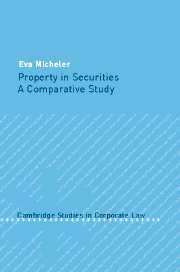Book contents
- Frontmatter
- Contents
- Preface
- Table of legislation
- Table of cases
- Introduction
- 1 Convergence and path-dependence
- Part I English law
- Part II German and Austrian law
- 9 The historic starting point
- 10 Paper transfers
- 11 Impact on the institutional framework
- 12 Immobilisation and its legal analysis
- 13 Evidence of convergence?
- 14 Conclusions on German and Austrian law
- Part III Conclusions
- Select bibliography
- Index
12 - Immobilisation and its legal analysis
from Part II - German and Austrian law
Published online by Cambridge University Press: 28 July 2009
- Frontmatter
- Contents
- Preface
- Table of legislation
- Table of cases
- Introduction
- 1 Convergence and path-dependence
- Part I English law
- Part II German and Austrian law
- 9 The historic starting point
- 10 Paper transfers
- 11 Impact on the institutional framework
- 12 Immobilisation and its legal analysis
- 13 Evidence of convergence?
- 14 Conclusions on German and Austrian law
- Part III Conclusions
- Select bibliography
- Index
Summary
The conclusion of chapter 11 was that after German law had adopted the analysis that bearer securities constituted tangible movables, legal doctrine continued to develop the law of securities in the context of such movables. This played an important role in shaping the market infrastructure of both Germany and Austria: both countries developed a market infrastructure based on securities depositories rather than on owner registers.
Chapter 11 also referred to the fact that transfers of deposited securities are deemed to involve a transfer of possession of the underlying documents from the transferor to the transferee. The chapter also concluded that the rules on the good faith acquisition of title continued to be applied to protect transferees against adverse claims.
In this chapter, the legal analysis underlying transfers of deposited securities will be examined further. It will be shown that, over time, the legal analysis which was originally based on the BGB and the ABGB became the subject of special legislation.
Genesis of the statutory regime
1896 German statute
The first German statute specifically addressing securities was enacted in 1896. At the time, German banks held a significant number of securities certificates on behalf of their clients which were mostly kept on an unallocated basis. Problems arose in 1891 when the banking system faced a major financial crisis. Some banks discovered that there were shortfalls in securities; they did not possess sufficient securities to meet all their clients' claims.
- Type
- Chapter
- Information
- Property in SecuritiesA Comparative Study, pp. 193 - 217Publisher: Cambridge University PressPrint publication year: 2007



